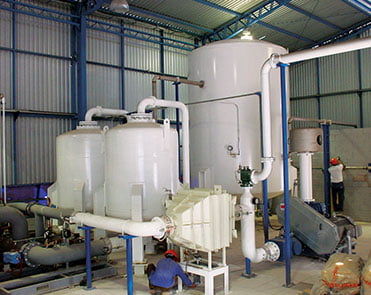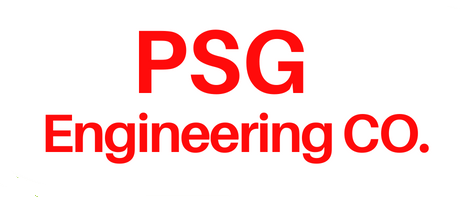- 493, Devlok Colony, Swarg Ashram Road, Hapur - 245101, Uttar Pradesh, India
- psgengineeringco@gmail.com
- +91-8126173604
How Does an Oxygen Generator Work?
An Oxygen Gas Generator operates on the principle of separating oxygen molecules from the air to produce a concentrated stream of oxygen gas. There are primarily two technologies used in oxygen generators: Pressure Swing Adsorption (PSA) and membrane separation. Here’s how each of these technologies works:
Pressure Swing Adsorption (PSA) Technology:
- Adsorption Process:
- Ambient air, which consists of approximately 78% nitrogen, 21% oxygen, and small amounts of other gases, is drawn into the oxygen generator.
- The air passes through a bed of zeolite or other adsorbent material within the generator’s chambers.
- Nitrogen molecules are preferentially adsorbed onto the surface of the adsorbent material, while oxygen molecules pass through.
- Separation of Gases:
- Initially, the adsorbent material adsorbs nitrogen molecules more readily due to its affinity, allowing oxygen-enriched air (containing higher concentrations of oxygen) to exit the adsorption chamber.
- Over time, as the adsorbent bed becomes saturated with nitrogen, the generator automatically switches to a regeneration phase.
- Regeneration Phase:
- To regenerate the adsorbent bed and release the adsorbed nitrogen, the pressure in the chamber is reduced (desorbed).
- This purges the nitrogen from the adsorbent material, allowing it to be vented out of the system.
- The cycle then repeats, alternating between adsorption (production) and desorption (regeneration) phases to continuously produce oxygen.

Membrane Separation Technology:
- Membrane Structure:
- Oxygen generators using membrane separation technology employ semi-permeable membranes that selectively allow oxygen molecules to pass through while blocking nitrogen and other gases.
- Gas Separation Process:
- Ambient air is compressed and directed into the membrane modules.
- Inside these modules, the air stream is separated into two streams: one enriched in oxygen and the other depleted in oxygen (containing primarily nitrogen and other gases).
- The membranes use differential permeability to separate oxygen molecules, allowing the enriched oxygen stream to be collected and directed to the outlet.
- Output and Efficiency:
- Membrane oxygen generators operate continuously without the need for regeneration cycles like PSA systems.
- They are particularly useful for applications requiring lower purity oxygen and where continuous operation and low maintenance are preferred.
an oxygen gas generator is a sophisticated apparatus designed to extract oxygen from ambient air efficiently. This is typically achieved through advanced technologies like Pressure Swing Adsorption (PSA) or membrane separation. Unlike traditional methods that rely on bulk oxygen cylinders, these generators produce oxygen on-site, providing a continuous and reliable supply without the logistical constraints of storage and delivery.
Applications Across Industries
1. Healthcare: In the medical field, oxygen is a lifeline. Oxygen gas generators ensure a steady stream of medical-grade oxygen for patients in hospitals and clinics. They are particularly crucial in intensive care units (ICUs), emergency rooms, and during surgeries where the demand for oxygen can fluctuate. By eliminating the need for frequent cylinder replacements and reducing the risk of supply shortages, these generators enhance patient care and operational efficiency.
2. Industrial Use: Beyond healthcare, industries such as metallurgy, glass manufacturing, and wastewater treatment rely heavily on oxygen gas for their processes. Oxygen gas generators cater to industrial demands by providing a cost-effective and environmentally friendly alternative to traditional oxygen supply methods. They enable precise control over oxygen purity and flow rates, optimizing production processes and minimizing operational downtime.
3. Environmental Applications: In environmental applications, oxygen gas generators play a crucial role in water treatment facilities and environmental remediation projects. By delivering oxygen directly to water bodies or treatment systems, these generators facilitate aerobic processes that improve water quality and ecosystem health. This capability is essential for maintaining sustainable practices and mitigating the impact of industrial activities on the environment.
Advantages of Oxygen Gas Generators
1. Cost Efficiency: By producing oxygen on-site, generators reduce operational costs associated with transportation, storage, and rental of conventional oxygen cylinders.
2. Reliability: Continuous production ensures a dependable oxygen supply, critical for applications where interruptions could have severe consequences.
3. Safety: With fewer handling procedures and reduced transportation risks, oxygen gas generators enhance workplace safety and compliance with regulatory standards.
4. Sustainability: By utilizing air as a raw material and minimizing energy consumption, these generators contribute to environmental sustainability compared to traditional oxygen production methods.
In conclusion, whether employing PSA or membrane separation technology, oxygen generators offer a reliable, efficient, and safe method to produce oxygen gas. They play a crucial role in various sectors, including healthcare, industry, and environmental applications, ensuring a continuous supply of oxygen while contributing to sustainability efforts and operational efficiency.
